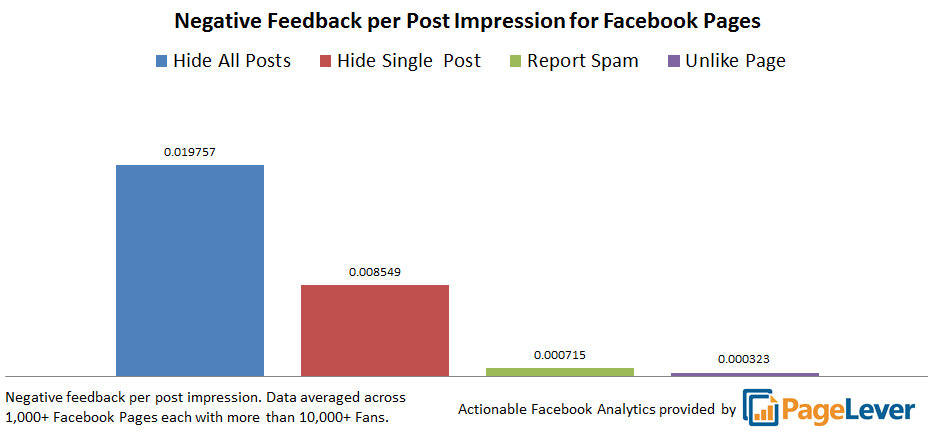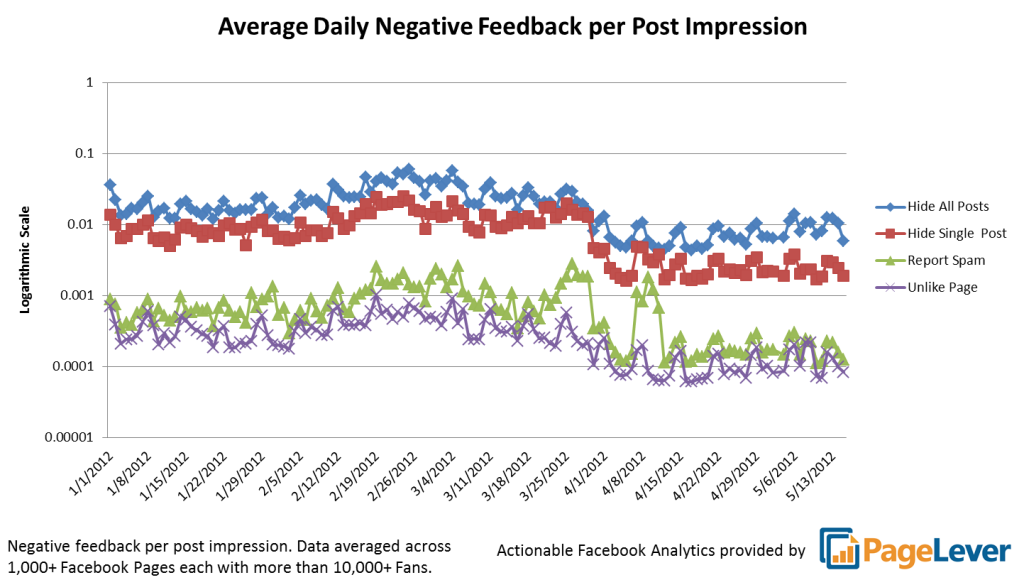Originally published in Fast Company
We are all counting numbers around our communities. After all, a thousand fans looks better than a hundred. But have you personally ever hid a post from a fan page? And have you, as a marketer, ever wondered how many of your fans actually do the same thing instead of unfanning it?
There are four types of negative feedback on Facebook ranging from undesirable to worst for a marketer:
- Hide: hides a single specific post from the user’s newsfeed
- Hide All: hides all the posts by that page from the user’s newsfeed. This used to be known as “unsubscribing”.
- Unlike Page: “unfan” the page
- Report spam: user thinks your page is spam
Negative feedback means your content isn’t aligned with your fan base. That doesn’t always mean your content is bad–sometimes you are delivering great content to the wrong audience. Or sometimes you are simply posting too frequently and overwhelming the users.
The importance of this metric seems to be dangerously underestimated by marketers.
I was curious how frequently fans take any of the above actions, so I asked the team at PageLever if they could share some benchmarks. PageLever is a Facebook analytics tool that provides much deeper insights than Facebook’s native Insights. They currently measure more than 1 billion Facebook fans across thousands of fan pages; so I consider their benchmarks to be pretty accurate. (Disclosure: Intel is a customer)
What they found was rather interesting. 98% of post views generate no negative feedback. But the other 2% of the time a fan responds with some form of negative feedback:


Note: The Y-axis on negative feedback over time uses a logarithmic scale. A linear scale made it impossible to see the Report Spam and Unlike Page because they were so small compared to Hiding Posts.
Results from the data:
- 1 out of 50 post views gets a negative response
- Facebook fans are most likely to block ALL your page stories when they take a negative feedback action, 60 times more likely than unfanning your page. Which means that just because your brand has a lot of fans doesn’t mean all those fans are seeing the page content. Some fans may have just hidden the page.
- Fans are more likely to report a post as spam than to unlike the page.
Why do 2% of fans unsubscribe?
For far too long marketers focused on maximizing fan count instead of maximizing fan engagement, and now we’re paying the price. This has nothing to do with Facebook’s algorithms and has everything to do with content marketers put in front of their fans … a lot of times content our fans don’t want to see.
What can marketers do to ensure that fans engage with them instead of hiding their content?
Your fans will remain loyal as long as the content remains relevant and expectations for frequency are met.
1) Focus your fan acquisition efforts on quality fans rather than quantity fans
Identify your ideal fans-–those are the folks who will truly engage with you because they love your product and your brand. Accept that a portion of your existing fans may no longer be interested in what you have to say, and don’t get frustrated if your unsubscribe rates are temporarily higher than this average of 2%. It may just mean that you need a different set of fans, not a new content strategy.
2) Stay on-topic with your content
Even the most loyal fan will leave after reading ten off-topic posts in a row. Be humble enough to admit you don’t always know what your fans want to read—so ask what they want to see.
Whether you run a poll or simply pose a question, it’s worth doing this at least once a quarter. Once you receive the feedback ensure you act on it, adjust your content strategy according to those findings.
In addition, track your metrics very closely to see which posts not only are getting the most engagement, but the most organic virality. Those are the topics that resonate.
3) Match your fans’ expectations for posting frequency.
How to time your Facebook posts to reach the most fans [http://mashable.com/2011/10/26/time-facebook-posts/] is a perennially popular topic, but just like an email list, it’s easy to wear out your fans, even with good content.
My recommendation is post once a day. If you have an event that offers a lot of good information, go for several times a day for several days of the event, but not more than that.
4) Tweak your copy so it’s recognizably your brand voice
Sometimes the problem isn’t that the content is off-topic, but that it’s off-voice. Your brand has a unique voice which your fans know and appreciate, so make sure your posts are phrased in a way your customers expect. And don’t forget that you are human, so write like a human, not like a PR professional.
5) Experiment
Finally, don’t be afraid to try new content, new format, and new approaches. You might be surprised what types of posts your fans might react to in the most positive way. The key with experimentation is not just trying new things, but measuring the results and adjusting in real time.
